Table of Contents
Dave Landry's Trading Simplified Plug-In
Welcome to the Trading Simplified indicator pack from Dave Landry. This StockChartsACP plug-in features six powerful but easy-to-use indicators that will help traders stay on the right side of the trend and keep their investing on track. These simple indicators have been used by Dave Landry for decades, and many are used as part of his 10% TFM (“Trend Following Moron”) trading system. Indicators like Landry Light and Landry Proper Order use color-coding to highlight conditions that can be harder to spot on the charts themselves, making these indicators especially useful for new traders.
Check out our Trading Simplified ACP Plug-in overview video below for a brief introduction to the plug-in, or read on for more details on the indicators and how to get the most out of this plug-in.
Landry Light
Developed by Dave Landry in the mid-1990s, the Landry Light indicator allows chartists to quickly identify the direction of the trend and how long it has been in place. An uptrend is in effect when the low for a price bar is above the specified moving average; and a downtrend is in effect when the high for a price bar is below the same moving average.
The indicator uses histogram bars color-coded based on the direction of the trend: green for uptrends and red for downtrends. Each bar represents the number of periods (for example, days on a daily chart) that the trend has been in place. The taller the histogram bar, the longer the trend has been going on. A reference line can be added at a certain number of periods, so it's easy to spot trends that are getting a little “long in the tooth” and may be due for a correction. This indicator can also be used to identify pullbacks to trade: watch for the indicator to show a green uptrend, drop back to the zero line, and then move above the zero line in an uptrend again.
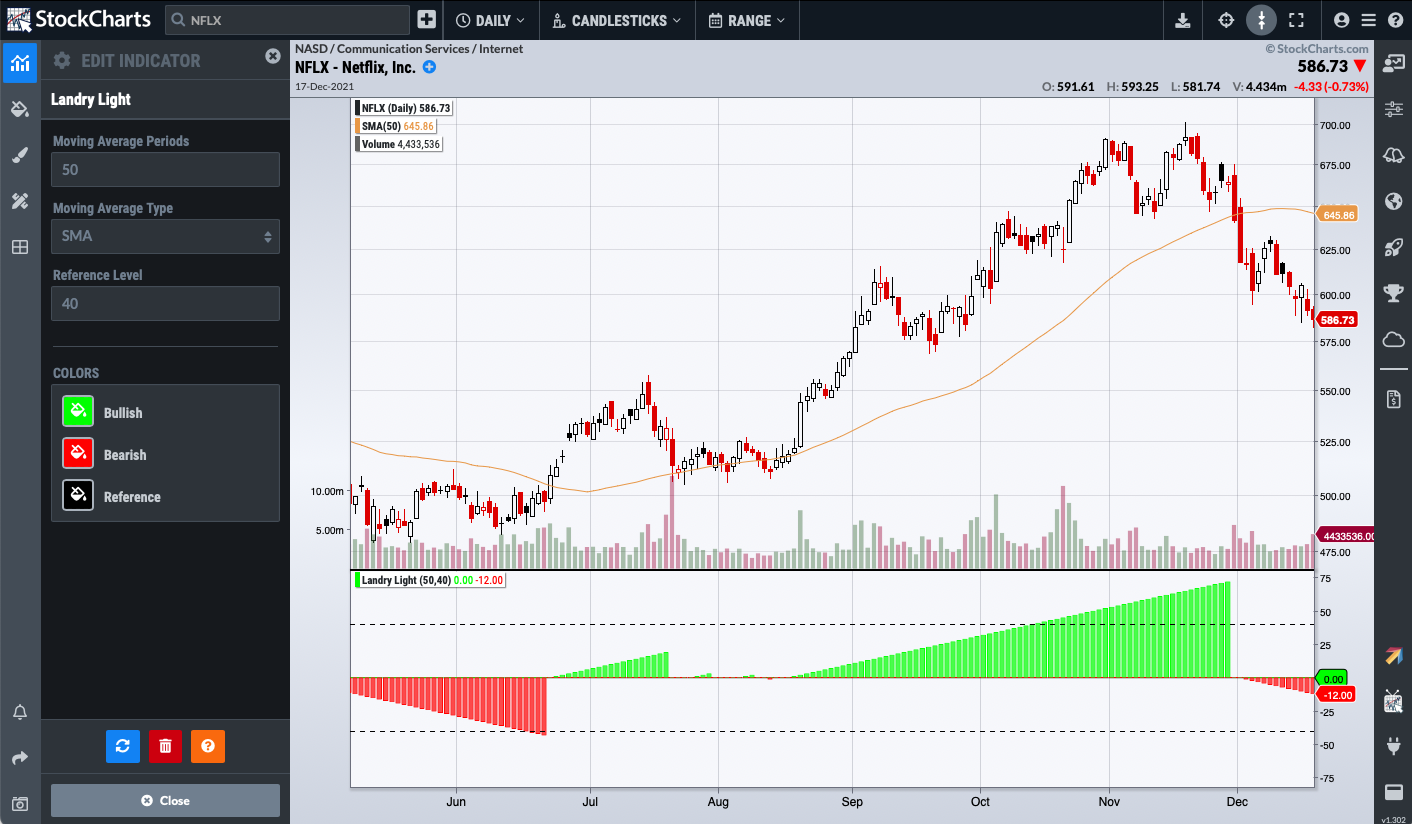
Landry Light can be used with long- or short-term charts. Dave recommends configuring the indicator to use an SMA for longer-term investing, and a faster-reacting EMA for shorter-term investing, including intraday. By default, the indicator uses a 50-period SMA with the reference line set at 40 periods, but these settings can be adjusted to meet your trading needs.
You may also want to add a moving average overlay of the same type and number of periods as the one used in the Landry Light indicator. The histogram bars of the indicator only show the duration of the trend, so having the moving average plotted on the chart can help you see the magnitude of the move as well.
Landry Proper Order
In uptrends, shorter-term moving averages are typically above longer-term ones (and vice versa in a downtrend). The Landry Proper Order indicator uses the three Landry BowTie moving averages, and allows you to easily see when they are in the “proper” order for an uptrend (10SMA > 20EMA > 30EMA) or a downtrend (10SMA < 20EMA < 30EMA). Like the Landry Light indicator, the height of the histogram bars show you how long the trend has been in effect.
The background of the indicator panel is color-coded:
- Green means an uptrend, and traders should consider going long
- Red means a downtrend, and traders should consider selling or going short
- Yellow means the averages are not in either uptrend or downtrend proper order, and traders should use caution because the market is choppy or the trend may be changing direction
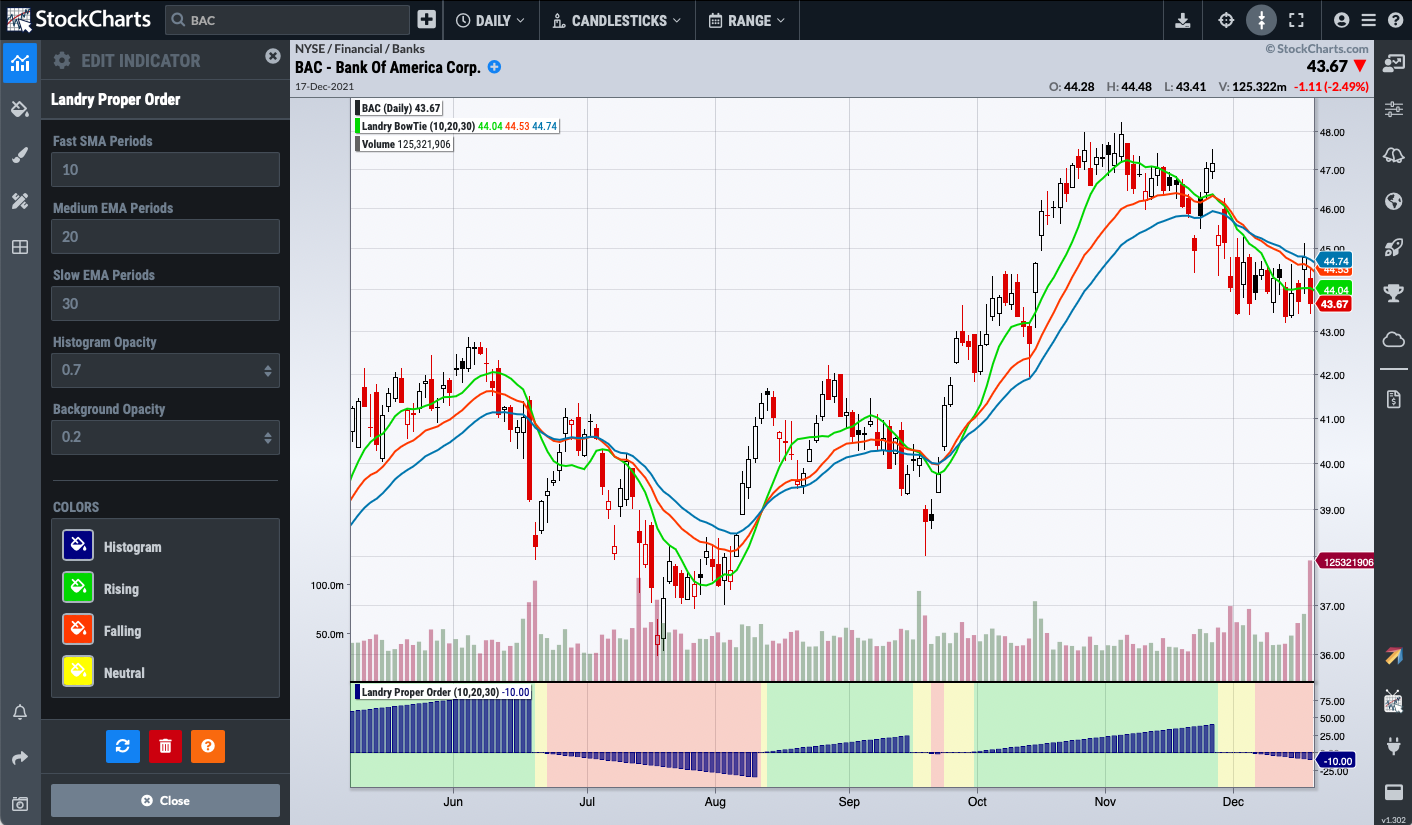
Landry Proper Order can be used with long- or short-term charts. Dave uses an SMA for the faster moving average in this indicator, and uses an EMA for the medium and slow averages, so that they will react more quickly and not lag the faster moving average as much. By default, the fast average uses 10 periods, the medium uses 20 periods, and the slow uses 30 periods, but these settings can be adjusted to meet your trading needs.
You may also want to add the Landry BowTie indicator to your chart, so you can see not just the order that the three moving averages are in, but how far apart they are from each other.
Percent From Closing High
Markets that are near their closing highs are healthy and those that are moving away from their recent closing highs are not. The Percent From Closing High indicator shows traders whether prices are near recent highs. Originally created for longer-term market timing as part of Dave's 10% TFM trading system, this simple indicator can be used in a variety of markets and timeframes.
The closing high is the highest value the stock has closed at during the specified lookback period. The histogram bars show the percentage below that recent closing high for each price bar. If the value is zero, the stock closed at its high. If the value is 12, the stock closed 12% below its closing high. Typically traders want a stock to be within 10% of its closing high, so a dashed reference line is placed at that level on the indicator. Dave's recommendation is to go long when the histogram bars are below the reference line; and sell or go short when the histogram bars are above the line.
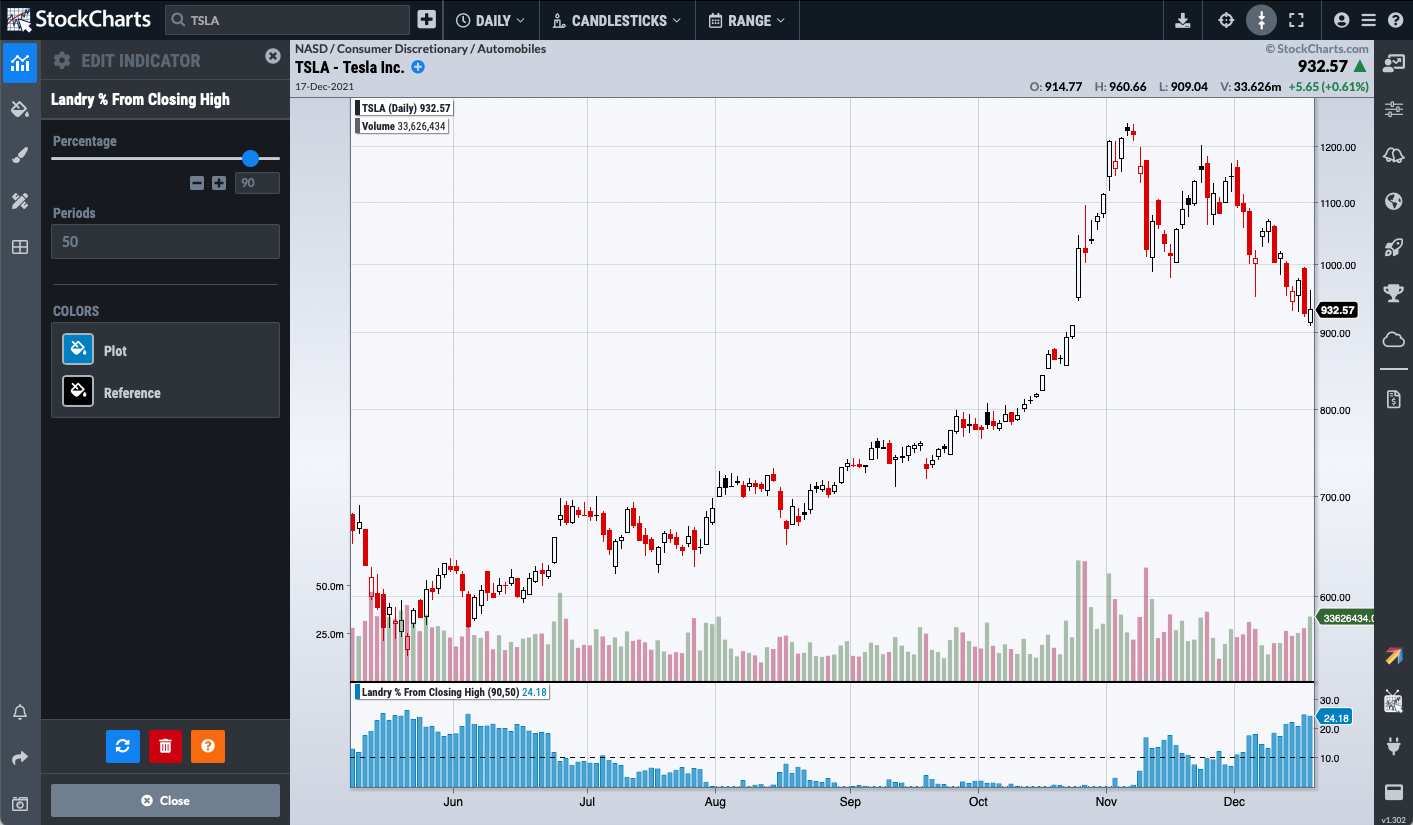
Landry's Percent From Closing High indicator can be used with long- or short-term charts. By default, the lookback period is set to 50 periods and the reference line is placed at 10%, but these settings can be adjusted to meet your trading needs.
NOTE: You may notice that the percentage is set at 90 by default, but the reference line is placed at 10% on the indicator. This is a quirk of the indicator: when the price is 10% below the closing high, it is at 90% of the closing high's price. So, subtract the desired reference line percentage from 100%, and enter the resulting number in the Percentage field.
Percent of Close
This indicator is similar to Landry's Percent From Closing High, but plots the information directly on the chart. The Percent of Close line essentially shows what the price would be if the stock closed 10% below the closing high for the specified lookback period.
Dave's recommended strategy is to go long when the price bars are above the Percent of Close line; and sell or go short when the price bars are below the line.
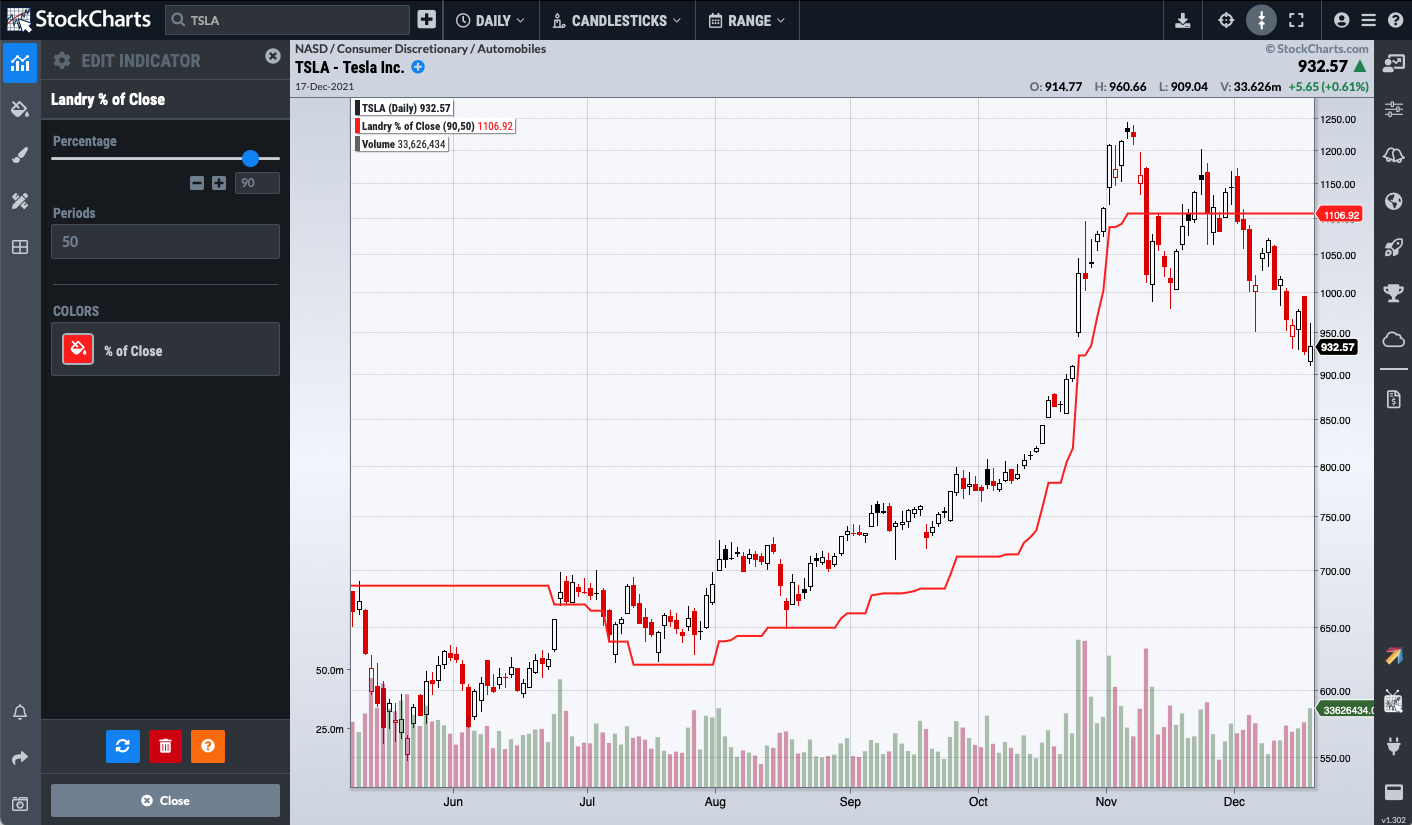
Landry's Percent of Close indicator can be used with long- or short-term charts. By default, the lookback period is set to 50 periods and the overlay line is calculated for 10% below the closing high, but these settings can be adjusted to meet your trading needs.
NOTE: As with the Percent From Closing High indicator, the Percentage field is set to 90 by default, but the overlay line is calculated for 10% below the closing high. This is a quirk of the indicator: when the price is 10% below the closing high, it is at 90% of the closing high's price. So, subtract the desired percentage from 100%, and enter the resulting number in the Percentage field.
Landry BowTie
Similar to the Landry Proper Order indicator, this overlay compares a fast, medium, and slow moving average (by default, a 10-period SMA, a 20-period EMA, and a 30-period EMA) to identify the current trend and spot possible trend reversals. In uptrends, the 10SMA should be above the 20EMA, which should in turn be above the 30EMA; in downtrends, the order is reversed, with the 30EMA above the 20EMA, which is in turn above the 10SMA.
Dave recommends that traders watch for setups where the moving averages are in the proper order, going long when the 10SMA is on top and the 30EMA on the bottom. When the three averages start to come together and the order changes, this can signal a turning trend, and traders should exercise caution. When the 30EMA is on top and the 10SMA is on the bottom, this indicates a downtrend, and traders may consider selling or going short. The farther apart the lines are when in the proper order, the stronger the trend.
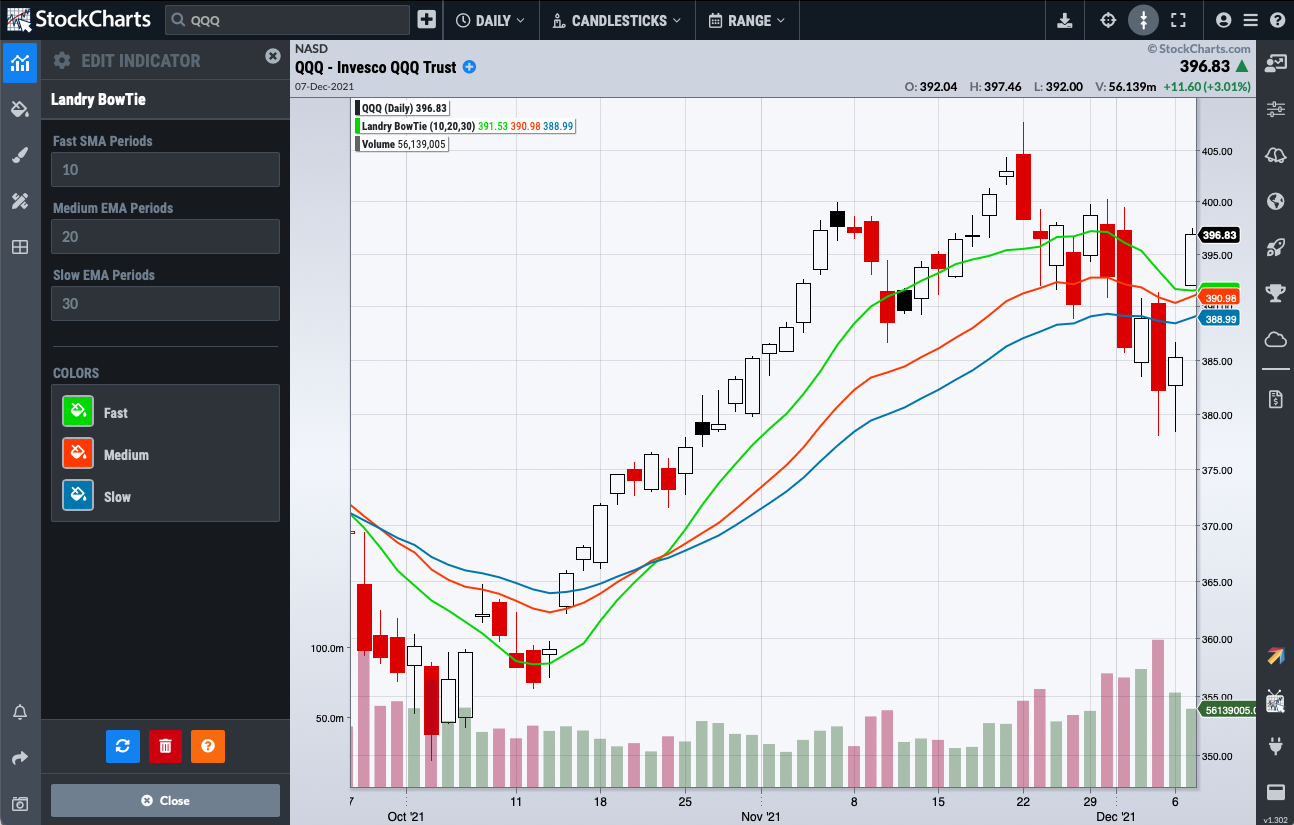
Landry BowTie can be used with long- or short-term charts. Dave uses an SMA for the faster moving average in this indicator, and uses an EMA for the medium and slow averages, so that they will react more quickly and not lag the faster moving average as much. By default, the fast average uses 10 periods, the medium uses 20 periods, and the slow uses 30 periods, but these settings can be adjusted to meet your trading needs.
NOTE: The Landry BowTie indicator gets its name because the contraction, crossover, and expansion of the three moving average lines can look like a bow tie, as in the example above.
Landry Volatility
Volatility helps traders estimate the potential size of price moves for a security; the greater the volatility, the more likely any price moves the security makes will be larger ones. The Landry Volatility indicator is simply annualized historical volatility for the specified symbol, and can be used by traders to determine the current volatility of a single stock or an entire market.
Chart the Landry Volatility indicator for a symbol like $SPX to gauge the volatility of the overall market, then chart the indicator for an individual stock to determine if its performance is more or less volatile than usual, as well as comparing it to the volatility of $SPX or another benchmark. There will be some natural variation in volatility between different securities, but traders will generally want to look for those with significantly greater volatility than the benchmark/market as a whole - within reason, of course. In the balancing act between the potential for big gains and the risk of big losses, Dave feels the sweet spot for day traders is a volatility value between 40 and 100.
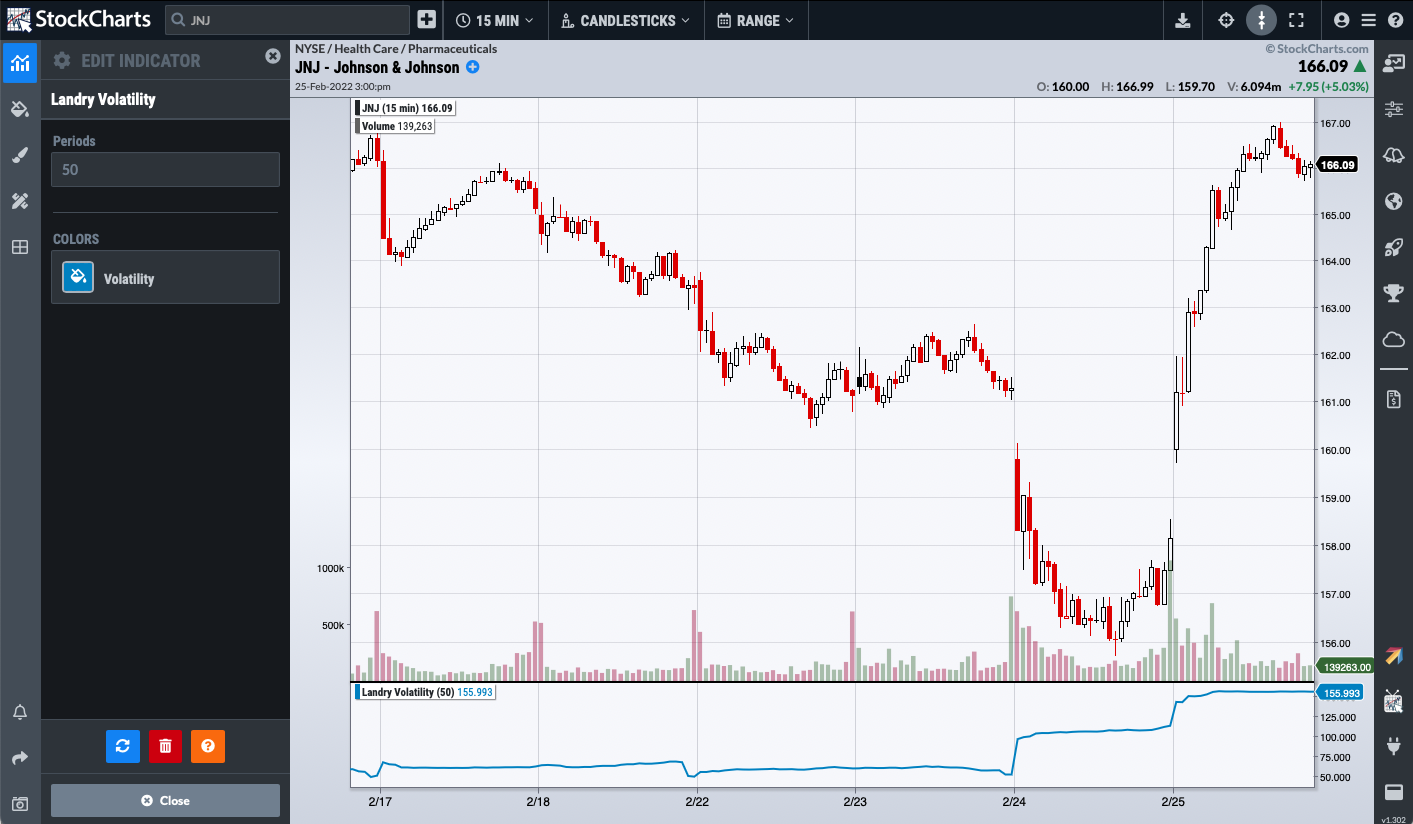
Landry Volatility can be used with long- or short-term charts; in fact, it can be useful to compare the volatility of a single symbol in different timeframes. By default, the indicator assesses the volatility over 50 periods, but this setting can be adjusted to meet your trading needs.